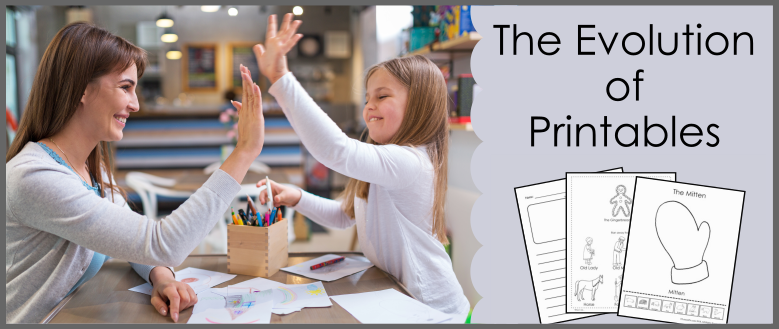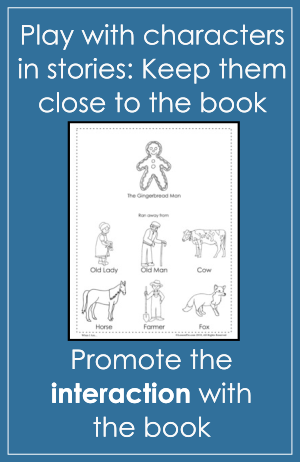
The Evolution of Printables
I recall the days during my own schooling experiences and during my student teaching some years ago, (I don't want to admit how many years), "worksheets", or "dittos", were an integral part of classroom learning. A student would enter the classroom, put his belongings away and collect a packet of worksheets to complete during morning arrival. Another packet (or the same packet) was offered during reading groups. While the teacher worked with the "redbird" group, the rest of the class sat silently and worked on their packet of... worksheets. When it came time for math, the teacher would instruct a full group lesson and then the class worked on problems from the book or more worksheets.
Some time between those days and now, the 'worksheets" became bad. I know of some teachers who secretly used worksheets, but put them away should an administrator walk in. Some argued that they felt worksheets provided a good way to document student progress and assess skill acquisition, but is it really?
I used worksheets as a child, so why are they bad now?
There are important changes from the days of dittos. When I look back at when I attended school (back in the old days), kindergarten was a 1/2 day voluntary program. Academics of learning to read and do math were taught in first grade, not pre-k. So when I was 3, 4 and 5, I played. I found creative ways to play inside and outside. I developed listening skills and phonemic awareness by hearing and distinguishing sounds all around me- not just from speakers in front of me from TV or a video game. I climbed trees, and when my spacial awareness was off, I fell. I made mistakes, got up and tried again. When my friends and I couldn't find things to do, we creatively made up our own games. This is not the case with children today.
What made these worksheets go bad? Were they ever good in the first place?
First worksheets are not "bad". In fact, worksheets can be used quite appropriately. If the students are older, they may be quite appropriate to measure skill acquisition or provide practice. Older students can think more abstractly and worksheets can provide opportunity for practice to learn skills. However, younger children are quite a different story. Worksheets, used in a traditional manner, can be far more damaging than beneficial to the young child.
- Young Children are not developmentally able to learn from 2-D worksheets: Children develop at different rates. So while some children may be more ready to manage concepts taught through worksheets, others will struggle. Children at this young age should be experimenting and exploring their world, trying different solutions. Through trial and error, children gain a deeper understanding of new concepts.
- Worksheets usually teach there is only one right answer. Children who succeed on the worksheet either comprehend the task or guessed correctly. Children who do not succeed will quickly learn what failure is, and begin to see themselves as a failure. And, because this sense of failure is developed at such a young age, it is difficult to overcome. These children begin to hate school, demonstrate behavior difficulties, or withdrawl.
- Skills taught through worksheets are often not generalized and transferred to other concepts. Children may become "worksheet-ized", knowing how to match the number 4 to the set of 4, but then have difficulty setting 4 plates, 4 forks, and 4 cups on the table given the direction. Worksheets are limited in the concepts they teach. Real objects are far better for children who are in this concrete (Preoperational) stage of development.
- Worksheets encourage children to write letters before they are developmentally ready, and form "bad" writing habits. Before children should sit with pencil and paper tasks, they need to develop the fine motor skills through tasks that require holding, pinching, lacing, squeezing, coloring, cutting, etc. Improper grasp and improper formation of letters may cause problems as they get older with muscle fatigue, as they begin to write longer passages. The muscle fatigue impacts their standardized testing in writing, and the student doesn't always connect why they have difficulty staying engaged in the writing process. Also, it is difficult for these children to transition to script.
- During a time when social-emotional skills are developing, it is more important that children learn work together. Worksheets focus on independent work. Teachers would say "keep your eyes on your own paper". However, most businesses are looking for people who can work as part of a team. In this process of collaborative learning, children not only learn the tasks, but gain a deeper understanding of the task, develop communication skills, and learn teamwork.
The primary focus of early childhood instruction is the ability to attend and lengthen attention span, and work well with peers. Worksheets do not promote either goal. The same children who have "the wiggles" during a 5 minute worksheet, can attend to constructing an elaborate block structure for 30 minutes. The wiggley children in a setting with worksheets may be easily diagnosed with "attention deficit", "hyperactivity" or just "immature".


There is no doubt that there is a bigger push for academics earlier and earlier. This can be seen by the huge market of "teach your baby to read". Just because you can teach a child skills doesn't mean you should. (Although my 12 year old is tall enough, she is not ready to drive my car.) There is always a debate on when and how to teach your child specific skills. My advice would be to follow each child's lead, keep it fun, provide real hands-on experiences, share a love of reading, and provide a print-rich environment. By holding a flashcard up to a toddler, what is the toddler learning? - to value paper scribbles rather than faces, that there is only one answer, and low-level recall pleases rather than higher-level creativity, problem solving, and thinking. If you skip teaching the steps, children miss important foundations to learning. For example, many girls who often transition quicker and more naturally to pencil and paper tasks, often struggle more with 3-D concepts such as geometry later in their education. When I use to tutor geometry, many girls had a very difficult time picturing a 3-D representation and struggled with concepts like "line AB intersect plane M". Perhaps they should have been encouraged to play blocks more often while their brains were still developing.
Parents like to see worksheets as progress of their child's development. Although this is true, there are many other ways to collect data and track progress of development and skills acquisition. Portfolios are a great way to show progress. They may include photos, observation anecdotes, and work samples.
What is the difference between "worksheets" and "printables"?
Worksheets go by many names, "dittos" (from the old ditto machines) to "worksheets" (usually photocopied from books) to "printables" that can be printed from your computer. The term "printable" can be expanded beyond just worksheets to items printed from your computer to use for games and/or learning. Printables may include games for a baby shower or getting to know you activity at a conference. In education, printables include worksheets.
Can printables or worksheets ever be used in an early childhood classroom?
The answer is yes definitely! Just keep in mind the primary goals for the early childhood classroom - build attention span and learn to work together.
The best way to use printable is to either tie them to real objects or foster collaborative work. They are supporting learning rather than the primary vessel of instruction. For example Bingo games can be used for teaching concepts and collaboration. Math mats can be used for sorting, graphing, and adding to use with manipulatives. Picture cards can be used in multiple settings such as memory games, visuals for schedules or directions, sequencing story details, or labeling for activities or materials. Word wall words can be generated with pictures and words to help create a print-rich classroom. Coloring pages can be used to make puppets, art projects, and character class books.
Look for cool ways to use old worksheets
Old Writing worksheets can be used in many ways.
- Look for old worksheets with larger print, laminate the worksheet and have the students use playdough to roll in the shape of letters.
- Offer a vibrating pen (wiggle pen) and see if the children can trace the letters do strengthen muscles and ability to control the pen.
- Have students take turns writing the letters on a worksheet using alternating colors to create a pattern.
- And when you can't decide how the worksheet can be used appropriately, have the students fold the worksheet into a paper airplane and have a flying contest!
Keep the learning objective in mind - it's not "busy work".
Truth is, helping a child lengthen time on preferred activities and transitioning to non-preferred activities will help a young child build the foundation to be ready for more abstract learning. The child who can stay engaged in building block structure, can be transitioned from 3-D representation to 2-D representation through play. One example, talk with a child who built a complex block structure, and ask them to draw a picture of their building before they clean up so it can be remembered. Another example, have a child who prefers to build with blocks, form letters with blocks and then trace the letters, in proper sequence, with a toy car or truck. Both of these strategies transition from concrete to representational and build the level engagement on a task- far better than any worksheet.
For therapy and special education, worksheets can be used appropriately in direct instruction, A speech therapist may use a phonics worksheet asking for the beginning letter sounds as he/she works on articulation skills. An occupational therapist may utilize appropriate worksheet for tracing with adapted writing utensils or pencil grips. These worksheet processes allow for trial and error and interaction with an adult.
Today's "printables" is the new evolution of worksheets with a broader range of uses. For an early childhood classroom, keep in mind that "worksheets" can be used appropriately. Just remember the following....
|
Use worksheets to promote.... |
|
Don't use worksheets to.... |
| Active learning | Foster passive learning | |
| Working together | Encouarge working alone | |
| Building self-confidence in abilities | Promote feelings of failure or frustration | |
| Creativity | Teach low-order thinking skills | |
| Trial and Error | Allow for only right or wrong | |
| Fun and motivating learning | Provide "busy work" | |
| Ties to real world / real objects | Teach to abstract concepts |
For more great ways to use Printables at Lessonpix.com, check out our sharing center.



 Facebook
Facebook Twitter
Twitter Pinterest
Pinterest